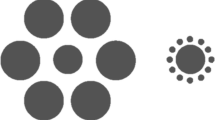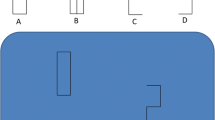Abstract
Psychophysical experiments were performed with the participation of 297 subjects (adults and 6- to 17-year-old children and adolescents). Perception of the size of a central stimulus surrounded by other stimuli was studied. Subjects had to estimate the size of a circle with a diameter of 22 angular min, which was surrounded by four similar figures with a diameter of either 11 or 44 angular min at a distance of either 11 or 33 angular min. The misperception of the stimulus size was dependent on the subject's age, the distance between the circles, and the size of the flanking circles. The smaller flanking circles located at any distance produced size underestimation in younger children; these circles led to size overestimation in case of their location at a short distance in most adults and adolescents. The larger flanking circles produced underestimation in all age groups, but, in adults, unlike children, this illusion decreased with increasing distance. The illusion mechanism and its possible connection with selective attention are discussed.
Similar content being viewed by others
REFERENCES
Bondarko, V.M. and Danilova, M.V., The Estimation of the Circle Size in the Ebbinghaus Illusion, Sensornye Systemy, 2000, vol. 14, no 4, p. 277.
Massaro, D.W. and Anderson, N.H., Judgmental Model of the Ebbinghaus Illusion, J. Experim. Psychol., 1971,vol. 89, no 1, p. 147.
Girgus, J.S., Coren, S., and Agdern, M., The Interrelationship between the Ebbinghaus and Delboeuf Illusions, J. Experim. Psychol., 1972, vol. 95, no. 2, p. 453.
Ehrenstein, W.H. and Hamada, J., Structural Factors of Size Contract in the Ebbinghaus Illusion, New Horizonsin the Study of Gestalt Perception, Sumi, S. and Noguchi, K., Eds., Japan: Keio Univ., 1996, p. 158.
Kovacs, I., Human Development of Perceptual Organization, Vision Res., 2000, vol. 40, nos. 10-12, p. 1301.
Weintraub, D.J. and Schneck, M.K., Fragments of Delboeuf and Ebbinghaus Illusions: Contour/Context Explorations of Misjudged Circle Size, Percept. Psychophysics, 1986, vol. 40, no 3, p. 147.
Girgus, J.S. and Coren, S., Assimilation and Contrast Illusion: Differences in Plasticity, Percept. Psychophysics, 1982, vol. 32, no 6, p. 555.
Author information
Authors and Affiliations
Rights and permissions
About this article
Cite this article
Bondarko, V.M., Semenov, L.A. Size Estimates in Ebbinghaus Illusion in Adults and Children of Different Age. Human Physiology 30, 24–30 (2004). https://doi.org/10.1023/B:HUMP.0000013760.85499.17
Issue Date:
DOI: https://doi.org/10.1023/B:HUMP.0000013760.85499.17




